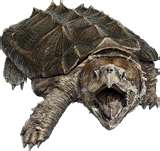|
|
Prolapses in Turtles
Prolapses are a somewhat common problem in turtles. A
prolapse is a medical condition in which some body part
turns inside out and sticks out of the body. In turtles, it
is usually the cloaca or the male's organ, but a large part
of the animal's intestine may also protrude. Such a
discovery on your part may be frightening-looking, but
unless the prolapse is intestine, it is not necessarily a
serious problem if treated properly. Prolapses seldom cause
pain and most don't cause permanent injury.
Experts are not certain as to the cause of prolapses in
turtles and tortoises. Every type of environments stress has
been suggested as a cause, from diet to genetics, but there
are no definite conclusions, so there are no guaranteed
preventative measures, although the best diet and
environment for your species will of course prevent many
medical issues. You will simply need to watch your turtles
and tortoises carefully and take care of prolapses if they
occur, before the turtle can injure the exposed parts.
Your turtle may have eaten something indigestible, such as
rocks or vivarium flooring, or it may simply have been
constipated by an inaccurate diet once too often. If you
have a particular animal that seems to have this problem
often, though, take it to your reptile veterinarian and the
vet likely can stop the problem with some minor surgery.

Care Suggestions:
If you notice that your turtle or tortoise has a prolapse,
immediately isolate it in a clean environment to protect the
vulnerable body part, and then simply keep watch, many
prolapses will reverse themselves in a short time. If the
prolapse continues for some time, and the turtle is a
tortoise and not already in clean water, make sure the
exposed part is kept moist. Put the tortoise into a shallow
pan of room temperature water if you want to, and massage
the area around the prolapse. Encourage the turtle to move
around in the water.
If you think the prolapsed body part is intestine, and it
doesn't revert after a short period, it is best to take the
turtle to your herptile veterinarian, because the turtle may
damage its intestine or the exposed part may be cut off from
nourishment and may die, inviting infection and far worse.
The veterinarian will probably need to do surgery and cut
out the damaged or dead intestinal part. This can be serious
surgery, and if your turtle survives you should keep it in
as clean an environment as possible until it has had time to
completely heal, watching carefully during this period to
make sure that its bowels seem to be working okay.
If, you are sure the prolapsed organ is the male turtle's
organ, and after a while the issue has not corrected itself,
you can try to gently (very gently!) push the prolapse back
into the turtle's body. If that doesn't work, get your
turtle to a veterinarian who is experienced with herptiles,
because it will probably need surgery.
|